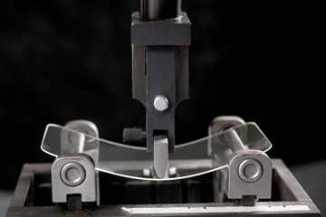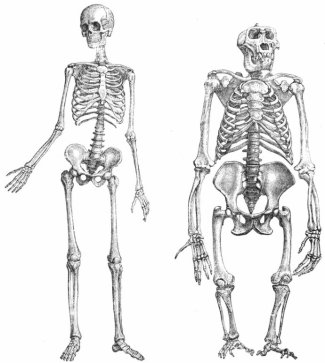I ran across another cool video in the web and wanted to share it, because I think it will give a new perspective to concentrate on the state of the planet from a politicosocial standpoint instead of focusing on a natural reason of devastation. Enjoy.
Category Archives: Science
The Future Is Here
Possibilities abound in the future for integrating our digital, social lives into appliances and places we have never seen. Provided Corning Inc. can ultimately get their Gorilla Glass to do what I think they want it to do. Super strong, paper thin, seamless, and fully application enabled Gorilla Glass is the wave of the future. Below is a video I stumbled upon.
Can this be possible? Yes, but it would require the glass be completed then all the app developers wouldn’t be able to wait to start programming apps for it. Goodbye Android. Goodbye iPhone. Hello Black and Decker Microwave.
How Apes Became Human Part 2: Bone Structure
As I discussed in part one, bipedalism, the ability to walk upright on two legs, was the first genetic transition that occured in the human-ape split timeline.
Indeed our ancestors’ anatomy underwent all sorts of basic changes to accomodate this new upright way of walking. Many of these changes that occured would have had to help the body stay balanced and comfortable by countering and stabilizing the weight bearing loads and keeping the upper body balanced above the feet. To walk upright in a habitual way, you have to do it in a synchronous manner. If your joints, muscles, and ligaments are not aligned properly it leads to injuries, which would have led the earliest ancestors to become prey, not predator.
The most crucial evolutionary changes in the bone structure were those in the torso, chest and spine. The distance between the chest and the pelvis is larger in humans than in apes, allowing the spine to curve pushing the upper body centered above the pelvis bones for balance. The pelvis grew wider and humans developed a hip joint and other ligaments that stabalize the pelvis, thats why humans do not sway side to side when they walk, apes do.
Even more changes took place in the legs. On the thighbone, the bent part at the top is broader in humans than in apes, which increases balance. The human knee, too, is specialized for upright movement. To compensate for the thighbones being angled, there’s a groove at the end of the femur to prevent the kneecap from sliding off the joint. An ape doesn’t have this groove due to the lack of angulation between the knee and the pelvis. This change meant you were biped.
Lastly, there is the foot. What’s so important here is the height difference in the arch of the foot. The arch is larger and higher on humans than on apes. The arch is a great shock absorber. To create such an arch the ape’s opposable big toe became aligned with the others, and the muscles and ligaments used to grasp trees repositioned under the foot.
Many other changes took place over millions of years and thousands of generations. In the next part I will discuss the evolutionary transits that occured on the exterior.
How Apes Became Humans Part 1: Bipedalism

For nearly 300 years, paleontologists have suspected that bipedalism, the ability to walk on two legs, was the first evolutionary transition that split the human genetic line from that of the apes, and skeletal remains from those such as Java Man and Lucy, have supported this claim.
I want to discuss and pin down the why. What caused apes to evolve the same bipedalism that would start the chain reaction of evolutions that would eventually turn Ardipithicus ramidas kadabba into homo sapiens.
We must first take a look back at the area and time from before the human line first began to evolve.
There is an area in Ethiopa called the middle awash. Today it is nothing more than a hot, harsh, rock desert punctuated by tree-lined rivers and patches of lava dried up by the twice-a-year torrent of rain.
But around 5.5 million years ago, the landscape was very different here. The land was almost a mile higher than it is today due to tectonic shifting. As a result the environment here was cooler and wetter and overgrown with grass, bushes and trees. It was a rainforest inhabited by primitive elephants, giant rats, pigs, monkeys, and horses, along with dozens of other species long since extinct.
It was around this time a new type of primate arose. An animal not so different than it’s knuckle-walking cousins before it including fur, a small brain and , except one thing. It walked on two legs upright instead of scurrying along like a chimp on all fours.
This much we know as scientific fact, but what I am interested in is the harder to figure out, why.
Common accepted knowledge is that Africa began to change around the time that humans first evolved. The changes, becoming drier and hotter, would have shown favor of grasslands over forests, deserts over lakes, and our ancestors began to evolve in order to take advantage of the new conditions.
We learned to walk upright, so goes the theory, to be able to spot predators and prey alike over the tall grasses. Also, an upright position as opposed to a hunched over position, makes for a smaller target for the hot blazing sun and a larger target for cooling breezes.
The only problem I see with that theory is that it is wrong. While walking upright may have begun as behavior, evolution demands an explanation as to why the behavior persisted throughout thousands of generations. Looking at it logically, walking upright just doesn’t make sense. For our earliest ancestors, walking upright on two legs would have been slower than walking on four legs while expending the same amount of energy.
My theory is that bipedalism persisted through generations for one reason. Sex.
Much like other primates will stand on their back legs to display their dominance, our ancestors did the same. Those that stood, walked, hunted, or ran upright the most or most proficiently got more and more sex leading to more and more offspring that were also proficient in waking upright.
If males were out hunting and bringing home the Miocene equivalent of the bacon, then they would need their hands free to carry it. Over time, females would only choose to mate with those males who brought them food. Those were the males who were best adapted at walking upright.
The evolutionary transition of walking upright on two legs from lumbering on four was a genetic reward from mother nature for sex. Just a byproductual transformation from a primate’s basic instinct.

